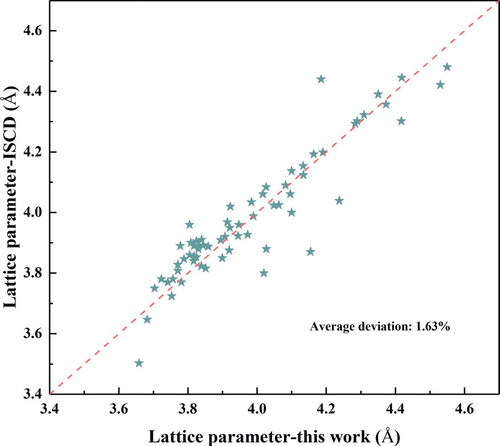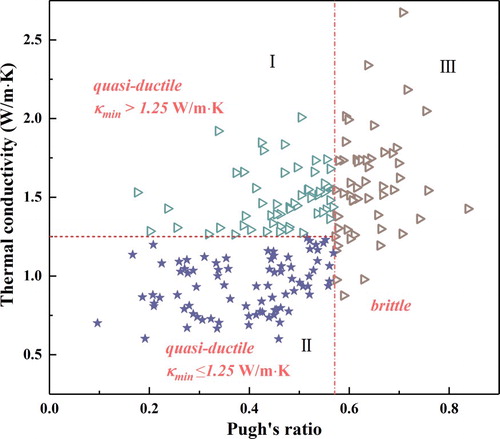 ?Mathematical formulae have been encoded as MathML and are displayed in this HTML version using MathJax in order to improve their display. Uncheck the box to turn MathJax off. This feature requires Javascript. Click on a formula to zoom.
?Mathematical formulae have been encoded as MathML and are displayed in this HTML version using MathJax in order to improve their display. Uncheck the box to turn MathJax off. This feature requires Javascript. Click on a formula to zoom.ABSTRACT
High-throughput first-principles calculations are performed on ABO3 perovskites for new thermal barrier coating (TBC) materials. We present systematic investigations comprised of multiple selection criteria to achieve the prediction of target materials. A database including mechanical/thermal properties of 190 perovskites is initially established. Six perovskites are proposed as novel TBC materials with predicted thermal conductivities under 1.25 W/(m·K) and good damage tolerance. The observed anisotropy of thermal conductivity provides possibilities for the performance controlling via the growth orientation design. The adopted strategy and established database are expected to inspire the design of ABO3-based TBC materials and future structural material investigations.
GRAPHICAL ABSTRACT

IMPACT STATEMENT
An investigation strategy for ceramics based on high-throughput calculations is constructed. Six perovskite oxides are predicted as new thermal barrier coating materials based on the established property database of perovskites.
1. Introduction
The ABO3 perovskites, a family of compounds having the same structure with CaTiO3, have been intensively studied since the middle of the twentieth century. An ideal perovskite crystallized in the Pmm group has cubic symmetry, with A cations occupying the body center, B cations the vertices and O anions on the middle of edges (Figure (a)). Due to the large variability in A and B cations and the subsequent interplay of structural, magnetic and transport related properties, a wide range of excellent physical/chemical properties including electro-optical effects, piezo-, ferro- and pyroelectricity, are commonly observed in this family [Citation1,Citation2]. As such, they have been proposed as electronic, magnetic, structural and refractory materials for various applications [Citation3–5]. Meanwhile, perovskite oxides with low thermal conductivities and good mechanical properties also meet the crucial performance requirements for TBC (thermal barrier coating) materials.
Figure 1. (a) The crystal structure of ABO3 perovskite. (b) Workflow of automated calculations and criteria for data screening. 313 ABO3 perovskites collected from MIP are set up as the initial materials for the automated calculations. 190 perovskites are identified as stable structures referring to the convergence and lattice stability criteria; meanwhile their mechanical and thermal properties are catalogued in database. At last, 6 materials are identified as promising TBC materials.
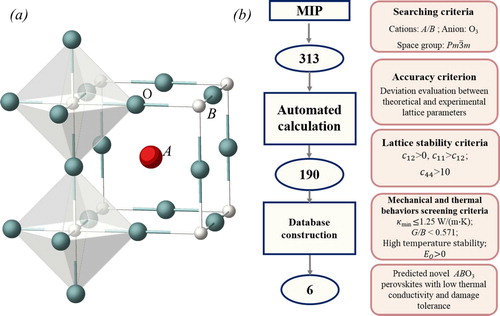
TBCs are ceramic coatings deposited onto the surface of gas turbine blades used in the hottest section of gas turbine engines to protect the superalloy substrate from the hot-gas stream [Citation6]. The critical function of TBCs demands materials that simultaneously have low thermal conductivity and sustainable mechanical behavior (i.e. good damage tolerance) during thermal cycling under severe operating conditions. The current commercial TBC material YSZ (Y2O3 partially stabilized ZrO2) has an application temperature limit of 1200°C and therefore cannot be used for the next generation of gas turbine engines with higher operating temperatures. Perovskites are a promising alternative for extremely high temperature TBC applications [Citation7], as experimental thermal conductivities can be as low as 2.08 W/(m K) for SrZrO3 and 1.65 W/(m K) for Yb2O3 doped SrZrO3 at 1000°C [Citation8–10]. However, the sparsity of data on mechanical and thermal properties of perovskites retard efforts towards realizing improved TBC materials. A grasp of the property distribution in perovskite oxide family and the construction of a proper screening strategy are necessary for accelerating the design and discovery of perovskite-based TBC materials.
As a burgeoning area of the material science [Citation11–13], high-throughput screening facilitates the generation and analysis of large quantities of data in an efficient manner for the prediction and tailoring of novel material properties. Herein, high-throughput screening employing first-principles calculations is conducted to map the intrinsic performance of perovskites as possible TBC materials. A multiple selection criteria approach is proposed to screen the data rationality. Sequentially, a detailed database containing the theoretical mechanical and thermal properties of 190 perovskites is established, which is available in Supplementary. Using this workflow, 6 ABO3 perovskites with low minimum thermal conductivity and good intrinsic quasi-ductility are predicted as promising TBC materials. The predicted thermal barrier materials and the related strategies are expected to guide not only the future TBC material development but also the design of structural materials with desired mechanical and thermal properties.
2. Methods
Automatic calculations are performed via our developed code adopting Vienna Ab initio Simulation Package (VASP.5.4.4) based on density functional theory (DFT) [Citation14]. The generalized-gradient approximation (GGA-PBEsol) [Citation15] is used as the exchange correlation functional in this work due to its good reproduction of experimental perovskite structures [Citation16]. A 500 eV cut-off energy and a 4 × 4 × 4 k-points mesh over Brillouin zone (BZ) in Morhorst-Pack method are adopted [Citation17]. Spin polarization is taken into account in all calculations. The convergence criterion is that the forces on individual atoms are less than 5 × 10−3 eV/Å. The second order elastic constants are calculated by generating four distorted unit cell structures for each strain pattern under the maximum strain amplitude of 0.4%. The mechanical properties are calculated using Voigt-Reuss-Hill approximation [Citation18–20] and the minimum thermal conductivity is calculated employing Clarke’s model that refers to the lowest limit of thermal conductivity at high temperatures [Citation21–23]. The defect formation energy of oxygen vacancy
is calculated by
, where
is the total energy of the supercell with the oxygen vacancy and
the total energy of the perfect supercell.
is the chemical potential of oxygen defined as ½ of the total energy of O2. All ABO3 structures are obtained from MIP (Materials Informatics Platform) [Citation24] that is a newly established repository with the ability of automated high-throughput calculations. All the structures are optimized in the automated workflow before further property evaluations.
3. Results and discussion
3.1. The multiple selection criteria approach and property database
The multiple selection criteria approach in the framework consists of four parts: (1) search settings to traverse the MIP, (2) the convergence criterion for structural optimization with an accuracy judgment of the calculation results, (3) lattice stability criteria for the perovskite structure screening and (4) criteria for the prediction of the perovskite TBC materials. The investigation strategy constructed in this work covers the entire process from the multi-criteria system to the terminal material prediction. The multiple filters are designed to implement the data check and error detection, which are supposed to spur further comprehensive studies for the structural ceramic development.
3.2. Initial material selection
313 ABO3 compounds were selected from the MIP following the search settings given in Figure (b). The convergence criterion of the structural optimization (as described below) evaluates the reliability of the structures within the DFT framework. As a quick evaluation, we employ 5 atom cubic unit cells for the high-throughput calculations at this stage. The credibility of the theoretical results is checked by comparing the calculated lattice parameters with available experimental data in ICSD [Citation25,Citation26], as illustrated in Figure . Deviations between the calculated and experimental values are quite low, with an average value of 1.63% (see Supplementary Table S1). The satisfactory reproducibility demonstrates the reliability of our DFT calculation strategy.
3.3. Mechanical stability selection criteria
The elastic tensor reflects the structural response to a given stress and/or strain. As it closely correlates to the natural characteristics of materials and governs the mechanical properties, the second order elastic constant is accepted as a critical descriptor for the prediction and design of materials with expected mechanical/thermal properties [Citation27]. However, experimental measurements of second order elastic constants are difficult because of the lack of single crystal samples and therefore only a small amount of experimental elastic constants are available in existing databases, which impede the exploration of materials with desired properties. Here, the second order elastic tensors (,
and
) of perovskites are generated from DFT calculations in the high-throughput framework after structural optimization. The lattice stability criteria based on second order elastic constants are defined as (1)
,
and (2)
. The lattice stability filter (1) refers to the Born-Huang stability criteria [Citation28] that the aforementioned two conditions have to be fulfilled for the cubic lattice to be stable. Filter (2) is our empirical criterion considering the structural stability of TBC candidates at high temperatures, where
corresponds to the resistance against shear deformations. Within the convergence and lattice stability criteria, 190 perovskites are found to possess good lattice stability. For each of these remaining structures, the intrinsic mechanical properties (bulk modulus B, shear modulus G, Young’s modulus E, Zener constant Z and Poisson’s ratio
, etc.) are predicted (see Supplementary Table S2).
3.4. Thermal conductivity selection criteria
Since low thermal conductivity is the dominant metric for TBC materials, the prediction of thermal conductivities are quite significant for potential TBC material searching. The theoretical minimum thermal conductivity is predicted based on the Clarke model [Citation21,Citation29]. For TBC applications, ≤ 1.25 W/(m K) is adopted as the cutoff after considering thermal conductivities of the widespread used TBCs, 1.2–1.8 W/(m K) for 7YSZ [Citation10], 1.5 W/(m K) for La2Zr2O7 [Citation22] and 1.3 W/(m K) for Gd2Zr2O7 [Citation30]. We find a total of 86 structures with thermal conductivities lower than this cutoff. The thermal properties (Debye temperature
, the minimum thermal conductivity
, etc.) for the 190 perovskites are listed in Supplementary Table S2.
3.5. Initial selection of candidate TBC materials
When it comes to the prediction of new TBC materials, challenges for the overall mechanical and thermal properties of employed structural materials brought by the harsh operating environments in engines should be faced directly. The basic performance requirement for the material is to own low thermal conductivity, meanwhile it is also crucial to be damage tolerant for a prolonged service life. For a measure of damage tolerance, we employ a quasi-ductility requirement. Pugh’s ratio defined as the ratio of shear modulus to bulk modulus G/B, is generally used for the prediction of the quasi-ductility of materials [Citation31,Citation32]. With a G/B beneath the boundary value of 0.571, materials tend to have good intrinsic quasi-ductility. As such, to identify materials suitable for TBC applications, we screen for perovskites with good damage tolerance (G/B < 0.571) and ultra-low minimum lattice thermal conductivity (min ≤ 1.25 W/(m K)). Figure displays the property distribution of the 190 perovskites for the cross considered criteria of Pugh’s ratio and thermal conductivity. Perovskites in the category II are predicted to be both quasi-ductile and have low thermal conductivity; thus narrowing the candidate pool to 79. Moreover, with the considerations of high temperature stability, perovskites composing of alkali metal elements or actinides in the aforementioned group are excluded. Finally, to eliminate materials that may have large electronic thermal conductivity, we omit materials with no band gap. This significantly reduces the candidate pool to 7 insulating perovskites.
3.6. Defect tolerance
A final check was performed to explore the oxygen vacancy formation energies, EO, of the remaining 7 perovskites (in a 2 × 2 × 2, 40-atom unit cell) was calculated with structure relax as described in the methods section. Surprisingly, only one of the structures BiScO3, was determined to be favorable to oxygen vacancy formation, EO = −2.94 eV, indicating the existence of a large amount of oxygen vacancies in BiScO3 ultimately leading to its structural degradation. The remaining six materials were found to be unstable to defect formations with positive formation energies of: 5.25 eV for BaCeO3, 2.38 eV for BiGaO3, 6.06 eV for EuHfO3, 0.61 eV for EuSbO3, 4.70 eV for TlNbO3 and 5.78 eV for TlTaO3. These are predicted to have polycrystalline minimum thermal conductivity ranging from 0.86 to 1.22 W/(m K) (Figure ). Together they are expected to possess structure stability, low thermal conductivity and mechanical stability, and should be ideal for application as novel TBC candidates.
Figure 4. The minimum thermal conductivity of 6 predicted low thermal conductivity ABO3 perovskites after considering the anisotropic nature.
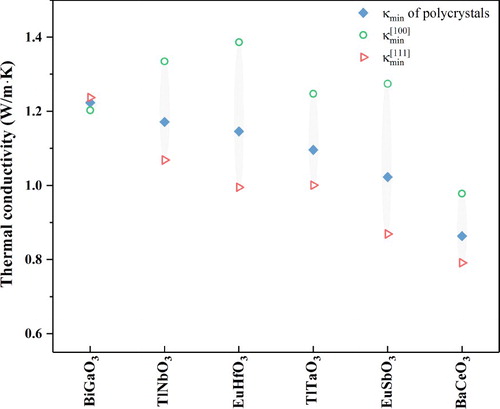
Lastly, the intrinsic anisotropy nature of the predicted 6 perovskites is discussed. Figure gives a holistic illustration on the anisotropic nature through comparing of polycrystals with
along [100] (
) and [111] (
) directions. For the perovskite compounds with a Zener constant over 1, a decreased value of
is reached in the [100] direction, otherwise the decreased
is along the [111] direction. The polycrystalline minimum thermal conductivities of the predicted 6 perovskites range from 1.22 to 0.86 W/(m K). The anisotropic considerations bring decreased thermal conductivities up to 15.1%. The discrepancy between
and
exhibited as the gray shadow area in Figure displays the tailorable ranges of the thermal conductivity. The mechanical/thermal properties of these 6 predicted ABO3 perovskites as well as their anisotropic thermal behaviors are listed in Supplementary information Table S3. Figure illustrates the directional dependent minimum shear moduli Gmin of the 6 predicted perovskites. The directions with the lowest shear modulus suggest the most likely slip systems for the materials. For perovskites of BaCeO3, EuHfO3, EuSbO3, TlNbO3 and TlTaO3, the minimum Gmin are in the [100] direction on (110) planes, while the corresponding value of BiGaO3 is in the [111] direction on (110) planes, manifesting that the slip system is [100] (110) for the former five perovskites but [111] (110) system for BiGaO3. The knowledge on the direction-dependent shear performance is helpful in determining the slip systems of materials and analyzing the fracture or failure modes. Moreover, knowing the shear anisotropy is also important in strengthening or weakening certain shear modes to tailoring the mechanical properties of perovskites.
Figure 5. Minimum shear modulus Gmin of (a) BiGaO3, (b) TlNbO3, (c) EuHfO3, (d) TlTaO3, (e) EuSbO3 and (f) BaCeO3.
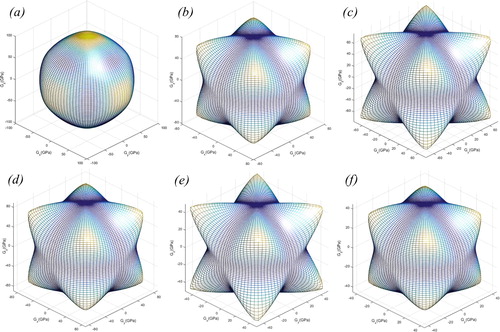
In terms of experiments, the directional crystal growth has been achieved in many techniques. For examples, Arunkumar [Citation33] disclosed that different annealing mechanisms of CeO2 films deposited via EBPVD (Electron Beam Physical Vapor Deposition) are correlated with the texture growth of (111) planes. In our previous work, the growth orientation of lanthanum zirconate coatings prepared by LCVD (Laser Chemical Vapor Deposition) differs depending on whether the laser irradiation exists. The major growth orientation is [111] with 16 W/cm2 laser irradiation assistance but [200] without laser irradiation [Citation34]. The feasibility of directional growth provides a route for improving thermal barrier effects by designing the crystal growth orientation. In conclusion, the combination of material screening and the crystal growth orientation design will open a new perspective for the exploitation of promising thermal barrier materials.
4. Conclusions
In summary, high-throughput first-principles calculations with a multiple selection criteria approach were employed to predict perovskite-based materials suitable for TBC applications. Six perovskites with the thermal conductivities below 1.25 W/(m K) and good damage tolerance are predicted as potential TBC materials. Our calculations further indicate that additional thermal barrier effects may be achieved through the orientation control during the deposition after considering their anisotropic nature. Subsequently, a mechanical and thermal property database containing 190 perovskite oxides was established, which is supportive of perovskite related studies. The investigation strategy, the established database and the predicted materials would be of great significance for accelerating the development of the structural and functional applications of ABO3 and ABO3-based perovskite materials. It is expected this strategy could further enlighten following investigations of high-throughput screening for other functional material fields.
Disclosure statement
No potential conflict of interest was reported by the authors.
Additional information
Funding
References
- Bhalla AS, Guo R, Roy R. The perovskite structure -a review of its role in ceramic science and technology. Mater Res Innovations. 2000;4(1): 3–26. doi: 10.1007/s100190000062
- Grabowska E. Selected perovskite oxides: characterization, preparation and photocatalytic properties—a review. Appl Catal B. 2016;186:97–126. doi: 10.1016/j.apcatb.2015.12.035
- Bannikov VV, Shein IR, Kozhevnikov VL, et al. Magnetism without magnetic ions in non-magnetic perovskites SrTiO3, SrZrO3 and SrSnO3. J Magn Magn Mater. 2008;320(6):936–942. doi: 10.1016/j.jmmm.2007.09.012
- Kakekhani A, Ismail-Beigi S, Altman EI. Ferroelectrics: a pathway to switchable surface chemistry and catalysis. Surf Sci. 2016;650:302–316. doi: 10.1016/j.susc.2015.10.055
- Menzler NH, Tietz F, Uhlenbruck S, et al. Materials and manufacturing technologies for solid oxide fuel cells. J Mater Sci. 2010;45(12):3109–3135. doi: 10.1007/s10853-010-4279-9
- Padture NP. Advanced structural ceramics in aerospace propulsion. Nat Mater. 2016;15(8):804–809. doi: 10.1038/nmat4687
- Liu Y, Liu B, Xiang H, et al. Theoretical investigation of anisotropic mechanical and thermal properties of ABO3 (A = Sr, Ba; B = Ti, Zr, Hf) perovskites. J Am Ceram Soc. 2018;101:3527–3540. doi: 10.1111/jace.15502
- Ma W, Mack DE, Vaßen R, et al. Perovskite-type strontium zirconate as a new material for thermal barrier coatings. J Am Ceram Soc. 2008;91(8):2630–2635. doi: 10.1111/j.1551-2916.2008.02472.x
- Ma W, Jarligo MO, Mack DE, et al. New generation perovskite thermal barrier coating materials. J Therm Spray Technol. 2008;17(5-6):831–837. doi: 10.1007/s11666-008-9239-4
- Clarke DR, Oechsner M, Padture NP. Thermal-barrier coatings for more efficient gas-turbine engines. MRS Bull. 2012;37(10):891–898. doi: 10.1557/mrs.2012.232
- Curtarolo S, Hart GL, Nardelli MB, et al. The high-throughput highway to computational materials design. Nat Mater. 2013;12(3):191–201. doi: 10.1038/nmat3568
- Emery AA, Saal JE, Kirklin S, et al. High-throughput computational screening of perovskites for thermochemical water splitting applications. Chem Mater. 2016;28(16):5621–5634. doi: 10.1021/acs.chemmater.6b01182
- Strasser P, Fan Q, Devenney M, et al. High throughput experimental and theoretical predictive screening of materials − a comparative study of search strategies for new fuel cell anode catalysts. J Phys Chem B. 2003;107(40):11013–11021. doi: 10.1021/jp030508z
- Kresse G, Furthmüller J. Efficient iterative schemes for ab initio total-energy calculations using a plane-wave basis set. Phys Rev B. 1996;54:11169–11186. doi: 10.1103/PhysRevB.54.11169
- Perdew JP, Ruzsinszky A, Csonka GI, et al. Restoring the density-gradient expansion for exchange in solids and surfaces. Phys Rev Lett. 2008;100(13):136406. doi: 10.1103/PhysRevLett.100.136406
- Yuk SF, Pitike KC, Nakhmanson SM, et al. Towards an accurate description of perovskite ferroelectrics: exchange and correlation effects. Sci Rep. 2017;7:43482. doi: 10.1038/srep43482
- Monkhorst HJ, Pack JD. Special points for Brillouin-zone integrations. Phys Rev B. 1976;13(12):5188–5192. doi: 10.1103/PhysRevB.13.5188
- Voigt W. Lehrbuch der Kristallphysik. Taubner: Leipzig; 1928.
- Reuss A. Berechnung der Fließgrenze von Mischkristallen auf Grund der Plastizitätsbedingung für Einkristable [Calculation of the flow limit of mixed crystals due to the plasticity condition for single crystals]. J Appl Math Mech. 1929;9(1):49–58. German.
- Hill R. The elastic behaviour of a crystalline aggregate. Proc Phys Soc. 1952;65:349–354. doi: 10.1088/0370-1298/65/5/307
- Clarke DR. Materials selection guidelines for low thermal conductivity thermal barrier coatings. Surf Coat Technol. 2003:163–164:67–74. doi: 10.1016/S0257-8972(02)00593-5
- Liu B, Wang J, Li F, et al. Theoretical elastic stiffness, structural stability and thermal conductivity of La2T2O7 (T = Ge, Ti, Sn, Zr, Hf) pyrochlore. Acta Mater. 2010;58(13):4369–4377. doi: 10.1016/j.actamat.2010.04.031
- Sun Z, Li M, Zhou Y. Thermal properties of single-phase Y2SiO5. J Eur Ceram Soc. 2009;29(4):551–557. doi: 10.1016/j.jeurceramsoc.2008.07.026
- Materials Informatics Platform. Available from: http://mip.shu.edu.cn.
- Bergerhoff G, Brown ID. Crystallographic databases. Vol. 360. Allen FH, editor. Chester: International Union of Crystallography; 1987.
- Karlsruhe F. NIST. The Inorganic Crystal Structure Database (ICSD).
- Jong MD, Chen W, Angsten T, et al. Charting the complete elastic properties of inorganic crystalline compounds. Sci Data. 2015;2:150009. doi: 10.1038/sdata.2015.9
- Born M, Huang K. Dynamical theory of crystal lattices. Great Britain: Oxford University Press; 1954.
- Sun Z, Zhou Y, Wang J, et al. Thermal properties and thermal shock resistance of γ-Y2Si2O7. J Am Ceram Soc. 2008;91(8):2623–2629. doi: 10.1111/j.1551-2916.2008.02470.x
- Lehmann H, Pitzer D, Pracht G, et al. Thermal conductivity and thermal expansion coefficients of the lanthanum rare-earth-element zirconate system. J Am Ceram Soc. 2003;86(8):1338–1344. doi: 10.1111/j.1151-2916.2003.tb03473.x
- Pugh SF. Relation between the elastic moduli and the plastic properties of polycrystalline pure metals. Philos Mag. 1954;45(367):823–843. doi: 10.1080/14786440808520496
- Gilman JJ. Electronic basis of the strength of materials. Cambridge: Cambridge University Press; 2008.
- Arunkumar P, Ramaseshan R, Dash S, et al. Texturing of pure and doped CeO2 thin films by EBPVD through target engineering. RSC Adv. 2014;4(63):33338. doi: 10.1039/C4RA04353G
- Yang G, Mao X, Wang D, et al. Fabrication of columnar structured lanthanum zirconate films by laser CVD. J Am Ceram Soc. 2017;100(9):4232–4239. doi: 10.1111/jace.14923

